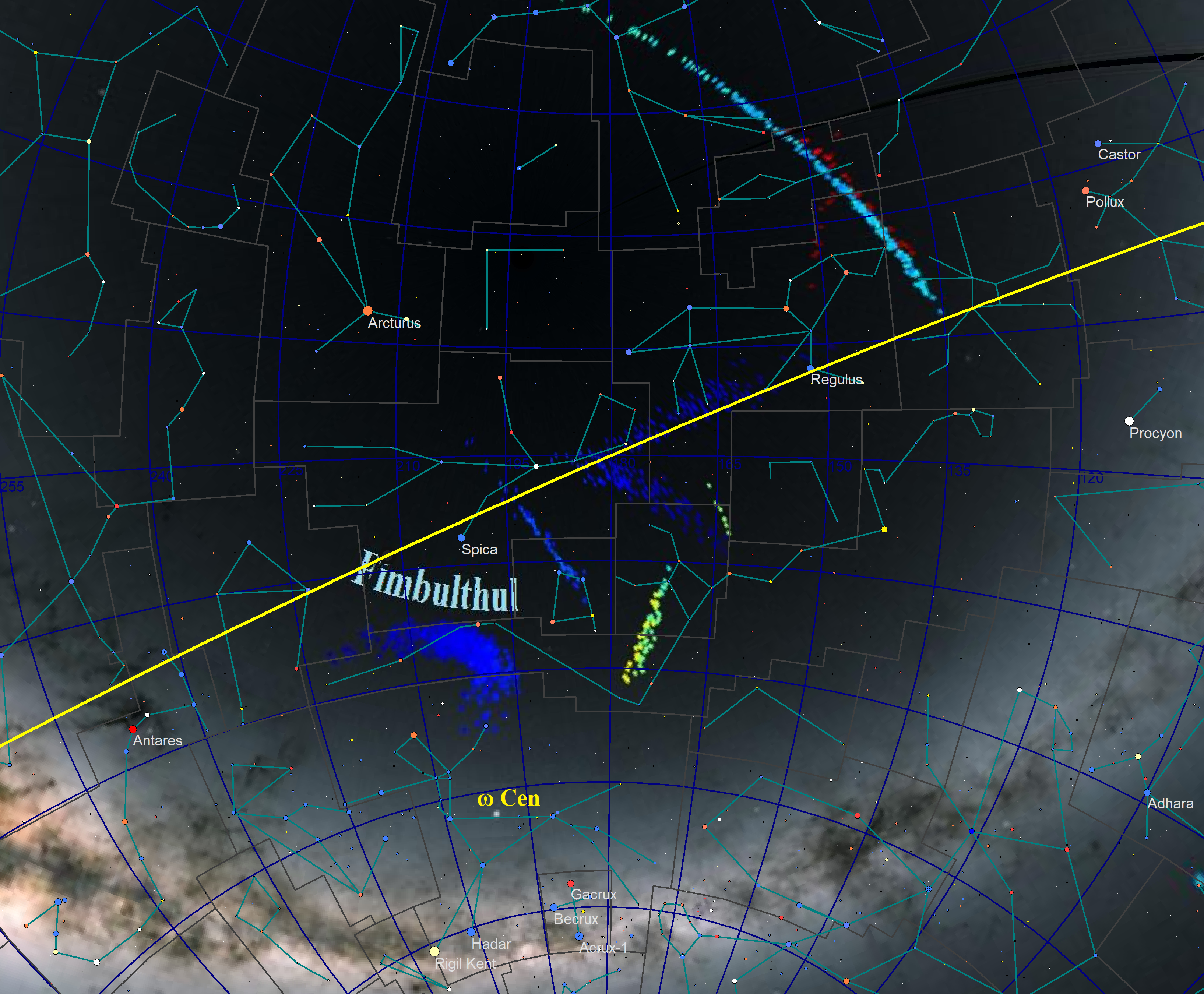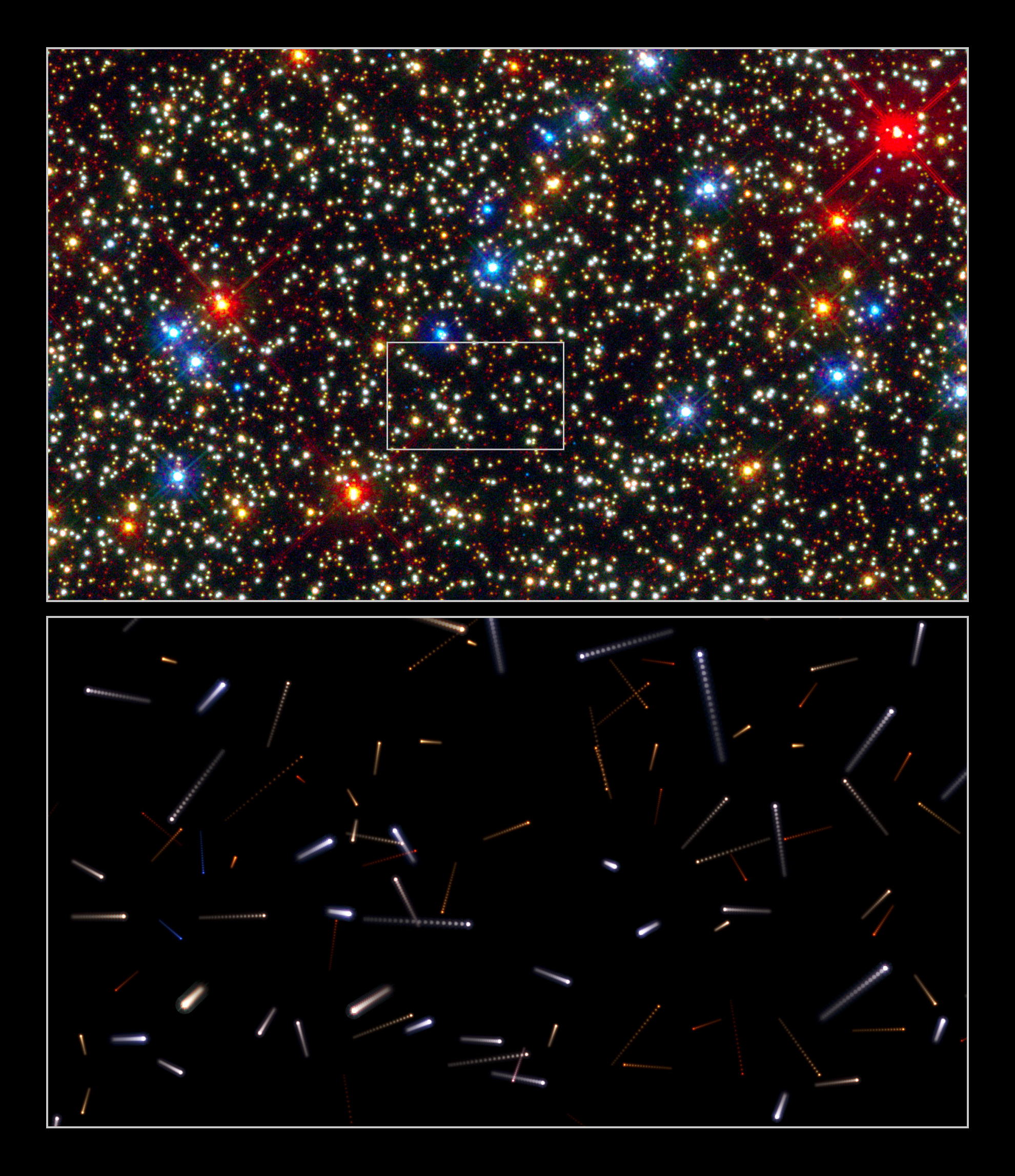|
Fimbulthul Stream
Fimbulthul is a tidal stellar stream torn off from Omega Centauri, the largest globular cluster of our Milky Way galaxy. The stream contains 309 known stars stretching over 18° in the constellations of Hydra and Centaurus, matching the same age as the globular cluster. Omega Centauri is considered the nucleus of a dwarf galaxy that merged with the Milky Way. The stream was discovered in the Gaia DR2 star database that determined the direction, distances and motion of over one billion stars. Khyati Malhan, Apr 23, 2019 The name [...More Info...] [...Related Items...] OR: [Wikipedia] [Google] [Baidu] |
List Of Stellar Streams
This is a list of stellar streams. A stellar stream is an association of stars orbiting a galaxy that was once a globular cluster or dwarf galaxy that has now been torn apart and stretched out along its orbit by tidal forces. An exception in the list about Milky Way streams given below is the Magellanic Stream, composed of gas (mostly hydrogen). Local Group streams Milky Way streams Andromeda Galaxy streams Streams beyond the Local Group See also * Lists of astronomical objects * List of nearby stellar associations and moving groups * Field of Streams * Stellar kinematics * Galaxy merger * Local Bubble * Satellite galaxies of the Milky Way The Milky Way has several smaller galaxies gravitationally bound to it, as part of the Milky Way subgroup, which is part of the local galaxy cluster, the Local Group. There are 59 small galaxies confirmed to be within of the Milky Way, but not a ... References Further reading * External links * * * * * {{Portal bar, Sta ... [...More Info...] [...Related Items...] OR: [Wikipedia] [Google] [Baidu] |
Omega Centauri
Omega Centauri (ω Cen, NGC 5139, or Caldwell 80) is a globular cluster in the constellation of Centaurus that was first identified as a non-stellar object by Edmond Halley in 1677. Located at a distance of , it is the largest-known globular cluster in the Milky Way at a diameter of roughly 150 light-years. It is estimated to contain approximately 10 million stars, and a total mass equivalent to 4 million solar masses, making it the most massive-known globular cluster in the Milky Way. Omega Centauri is very different from most other galactic globular clusters to the extent that it is thought to have originated as the core remnant of a disrupted dwarf galaxy. Observation history In 150 AD, Greco-Roman writer and astronomer Ptolemy catalogued this object in his ''Almagest'' as a star on the horse's back, "Quae est in principio scapulae". German cartographer Johann Bayer used Ptolemy's data to designate this object "Omega Centauri" with his 1603 publication of ''Uranometria''. Usin ... [...More Info...] [...Related Items...] OR: [Wikipedia] [Google] [Baidu] |
Globular Cluster
A globular cluster is a spheroidal conglomeration of stars. Globular clusters are bound together by gravity, with a higher concentration of stars towards their centers. They can contain anywhere from tens of thousands to many millions of member stars. Their name is derived from Latin (small sphere). Globular clusters are occasionally known simply as "globulars". Although one globular cluster, Omega Centauri, was observed in antiquity and long thought to be a star, recognition of the clusters' true nature came with the advent of telescopes in the 17th century. In early telescopic observations globular clusters appeared as fuzzy blobs, leading French astronomer Charles Messier to include many of them in his catalog of astronomical objects that he thought could be mistaken for comets. Using larger telescopes, 18th-century astronomers recognized that globular clusters are groups of many individual stars. Early in the 20th century the distribution of globular clusters in the sky w ... [...More Info...] [...Related Items...] OR: [Wikipedia] [Google] [Baidu] |
Milky Way
The Milky Way is the galaxy that includes our Solar System, with the name describing the galaxy's appearance from Earth: a hazy band of light seen in the night sky formed from stars that cannot be individually distinguished by the naked eye. The term ''Milky Way'' is a translation of the Latin ', from the Greek ('), meaning "milky circle". From Earth, the Milky Way appears as a band because its disk-shaped structure is viewed from within. Galileo Galilei first resolved the band of light into individual stars with his telescope in 1610. Until the early 1920s, most astronomers thought that the Milky Way contained all the stars in the Universe. Following the 1920 Great Debate between the astronomers Harlow Shapley and Heber Curtis, observations by Edwin Hubble showed that the Milky Way is just one of many galaxies. The Milky Way is a barred spiral galaxy with an estimated D25 isophotal diameter of , but only about 1,000 light years thick at the spiral arms (more at the bulg ... [...More Info...] [...Related Items...] OR: [Wikipedia] [Google] [Baidu] |
Hydra (constellation)
Hydra is the largest of the 88 modern constellations, measuring 1303 square degrees, and also the longest at over 100 degrees. Its southern end borders Libra and Centaurus and its northern end borders Cancer. It was included among the 48 constellations listed by the 2nd century astronomer Ptolemy. Commonly represented as a water snake, it straddles the celestial equator. History and mythology Western mythology The Greek constellation of Hydra is an adaptation of a Babylonian constellation: the MUL.APIN includes a "serpent" constellation (MUL.DINGIR.MUŠ) that loosely corresponds to Hydra. It is one of two Babylonian "serpent" constellations (the other being the origin of the Greek Serpens), a mythological hybrid of serpent, lion and bird. The shape of Hydra resembles a twisting snake, and features as such in some Greek myths. One myth associates it with a water snake that a crow served Apollo in a cup when it was sent to fetch water; Apollo saw through the fraud, and angr ... [...More Info...] [...Related Items...] OR: [Wikipedia] [Google] [Baidu] |
Centaurus
Centaurus is a bright constellation in the southern sky. One of the 88 modern constellations by area, largest constellations, Centaurus was included among the 48 constellations listed by the 2nd-century astronomer Ptolemy, and it remains one of the 88 modern constellations. In Greek mythology, Centaurus represents a centaur; a creature that is half human, half horse (another constellation named after a centaur is one from the zodiac: Sagittarius (constellation), Sagittarius). Notable stars include Alpha Centauri, the nearest star system to the Solar System, its neighbour in the sky Beta Centauri, and V766 Centauri, one of the largest stars yet discovered. The constellation also contains Omega Centauri, the brightest globular cluster as visible from Earth and the largest identified in the Milky Way, possibly a remnant of a dwarf galaxy. Notable features Stars Centaurus contains several very bright stars. Its alpha and beta stars are used as "pointer stars" to help observers ... [...More Info...] [...Related Items...] OR: [Wikipedia] [Google] [Baidu] |
Dwarf Galaxy
A dwarf galaxy is a small galaxy composed of about 1000 up to several billion stars, as compared to the Milky Way's 200–400 billion stars. The Large Magellanic Cloud, which closely orbits the Milky Way and contains over 30 billion stars, is sometimes classified as a dwarf galaxy; others consider it a full-fledged galaxy. Dwarf galaxies' formation and activity are thought to be heavily influenced by interactions with larger galaxies. Astronomers identify numerous types of dwarf galaxies, based on their shape and composition. Formation One theory states that most galaxies, including dwarf galaxies, form in association with dark matter, or from gas that contains metals. However, NASA's Galaxy Evolution Explorer space probe identified new dwarf galaxies forming out of gases with low metallicity. These galaxies were located in the Leo Ring, a cloud of hydrogen and helium around two massive galaxies in the constellation Leo. Because of their small size, dwarf galaxies have ... [...More Info...] [...Related Items...] OR: [Wikipedia] [Google] [Baidu] |
Gaia (spacecraft)
''Gaia'' is a space observatory of the European Space Agency (ESA), launched in 2013 and expected to operate until 2025. The spacecraft is designed for astrometry: measuring the positions, distances and motions of stars with unprecedented precision. The mission aims to construct by far the largest and most precise 3D space catalog ever made, totalling approximately 1 billion astronomical objects, mainly stars, but also planets, comets, asteroids and quasars, among others. To study the precise position and motion of its target objects, the spacecraft monitored each of them about 70 times over the five years of the nominal mission (2014–2019), and continues to do so during its extension. The spacecraft has enough micro-propulsion fuel to operate until about November 2024. As its detectors are not degrading as fast as initially expected, the mission could therefore be extended. ''Gaia'' targets objects brighter than magnitude 20 in a broad photometric band that covers the e ... [...More Info...] [...Related Items...] OR: [Wikipedia] [Google] [Baidu] |
Norse Mythology
Norse, Nordic, or Scandinavian mythology is the body of myths belonging to the North Germanic peoples, stemming from Old Norse religion and continuing after the Christianization of Scandinavia, and into the Nordic folklore of the modern period. The northernmost extension of Germanic mythology and stemming from Proto-Germanic folklore, Norse mythology consists of tales of various deities, beings, and heroes derived from numerous sources from both before and after the pagan period, including medieval manuscripts, archaeological representations, and folk tradition. The source texts mention numerous gods such as the thunder-god Thor, the raven-flanked god Odin, the goddess Freyja, and numerous other deities. Most of the surviving mythology centers on the plights of the gods and their interaction with several other beings, such as humanity and the jötnar, beings who may be friends, lovers, foes, or family members of the gods. The cosmos in Norse mythology consists of Nine Worl ... [...More Info...] [...Related Items...] OR: [Wikipedia] [Google] [Baidu] |
Milky Way Subgroup
The Milky Way has several smaller galaxies gravitationally bound to it, as part of the Milky Way subgroup, which is part of the local galaxy cluster, the Local Group. There are 59 small galaxies confirmed to be within of the Milky Way, but not all of them are necessarily in orbit, and some may themselves be in orbit of other satellite galaxies. The only ones visible to the naked eye are the Large and Small Magellanic Clouds, which have been observed since prehistory. Measurements with the Hubble Space Telescope in 2006 suggest the Magellanic Clouds may be moving too fast to be orbiting the Milky Way. Of the galaxies confirmed to be in orbit, the largest is the Sagittarius Dwarf Elliptical Galaxy, which has a diameter of or roughly a twentieth that of the Milky Way. Characteristics Satellite galaxies that orbit from of the edge of the disc of the Milky Way Galaxy to the edge of the dark matter halo of the Milky Way at from the center of the galaxy, are generally depleted in ... [...More Info...] [...Related Items...] OR: [Wikipedia] [Google] [Baidu] |






.jpg)

